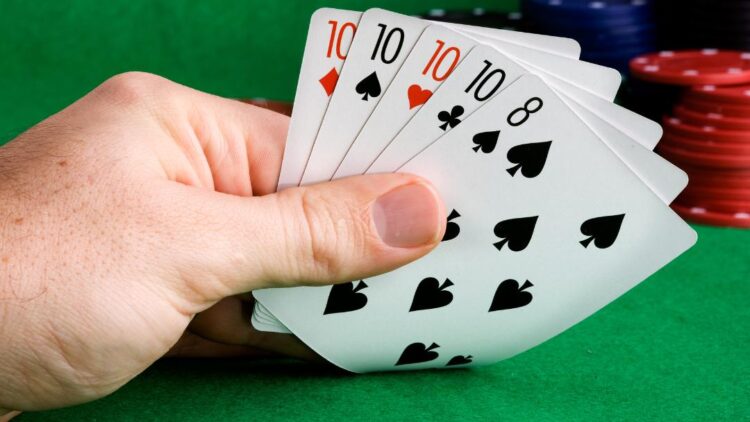
Poker is one of the most popular games in the world. This gambling game has an incredibly long history, and millions upon millions of people regularly play it around the world. While knowing how to play poker is important, if you’d like a more well-rounded knowledge of the game, you should dive in deep and get to know some cool poker facts. These also make for great conversation starters around the table in between games.
So, if you’re ready to impress your friends with your general knowledge of this uber-popular game, let’s dive into 15 poker facts that may very well surprise you!
POKER HISTORY FACTS

First up, let’s start with some history. As mentioned, poker has an incredibly long history, so you know there’s some really cool facts to discover here!
1. POKER HAS A HISTORY SPANNING 1,000 YEARS
It’s a pretty well-known fact that poker started in the American South in the 1800s, but the history of the game dates back hundreds of years before that! Some historians believe a version of poker first cropped up in the 10th century in China. Another forefather of poker takes us back to 16th-century Persia! But whatever its real origins, poker became popularized in France (when it was known as poque) in the 17th-century, after which it was brought to Canada and the US.
2. POKER MAY COME FROM DOMINOES
While we don’t know exactly when and where poker comes from, some historians believe that you can trace poker back to 10th-century China. However, unlike poker today, back then, it was a domino-card game that Emperor Mu-Tsung played. Bluffing was just as important to this domino-card poker game as it is now.
3. POKER CHIPS WERE ONCE GOLD
But if you’re thinking of gold poker chips, think again! When people first started playing poker in the American Old West, players used pieces of gold to gamble. However, soon after, in the mid- to late-1800s, casinos and saloons created standard round chips made of a variety of materials, such as wood, ivory, and clay.
4. POKER USED TO BE PLAYED WITH 20 CARDS
While we use the standard 52-card deck today, in the past, players played poker with just 20 cards. Eventually, the 52-card deck came to be in order to allow more people to play.
5. THE DEAD MAN’S HAND HAS SOME TRUTH TO IT
If you’ve played poker before, one myth you may have heard is the Dead Man’s Hand. This hand consists of two pairs of aces and eights. But where did this myth come from, you ask? Well, reportedly, these are the exact cards that Wild Bill Hickock held when he was shot dead while playing poker in 1876.
POKER RECORDS
There are some real fun facts you should get to know about poker games, including the longest games and the biggest winnings.
6. BIGGEST PAYOUT FROM A SINGLE TOURNAMENT WAS AROUND $18.3 MILLION
There are a couple of crazy things about this tournament. First of all, the CEO of Cirque Du Soleil, Guy Laliberte, decided to create a $1 million buy-in tournament, also called The Big One for One Drop. This tournament in 2012 took place in Las Vegas and started off with 48 players. The winner Antonio Esfandiari took home a record $18,346,673!
7. THE LONGEST POKER GAME LASTED 8.5 YEARS
Spanning 1881 to 1894, the longest-running poker game ever recorded spanned close to a decade. It went on continuously for 24 hours a day, 7 days per week for 8 years, 5 months, and three days. The game took place in the basement of The Bird Cage Theatre in the US city of Tombstone, Arizona.
During this time, historical figures such as Doc Holliday and George Hearst made appearances at the table. The buy-in was $1,000, and 10 percent of proceeds went to the Bird Cage.
8. THE LONGEST TIME AN INDIVIDUAL PLAYED POKER IS 115 HOURS
Phil Laak from Cyprus holds a Guinness World Record of the longest time a single person has continuously played poker with a whopping 115 hours! This streak took place at the Bellagio in Las Vegas from 2 to 7 June 2010.
9. THE LARGEST POKER TOURNAMENT IS THE WORLD SERIES OF POKER
It’s probably no surprise to you, but the largest poker tournament every year is the World Series, which hosts 7,000 players and over 100 events. The events cover all of the major poker variations, and the individuals play for a multi-million dollar prize at the end of the two-month tournament! Nowadays, there’s even an online series.
10. THE LONGEST CONTINUOUS POKER TOURNAMENT WENT FOR ALMOST 50 HOURS
The record for the longest continuous poker tournament goes to the Asian Poker Tour and Resorts World Manila Iron Man Poker Challenge hosted in the Philippines. This tournament lasted 48 hours, 55 minutes, and 58.5 seconds, with the winner, Damon Shulenberger, taking home $18,240.
POKER MATH FACTS

There’s a lot of probability in play when you play poker, so knowing some of the math behind it can be very useful behind the scenes.
11. THE PROBABILITY OF A ROYAL FLUSH
Yes, a royal flush is an incredibly rare poker hand, but it doesn’t mean you’ll never see it. If using a standard 52-card deck, you may see a royal flush every 649,739 hands. In other words, you have a 0.000154% chance of getting it dealt to you. But if you play with a smaller 36-card deck, the probably increases!
12. THERE ARE 2.6 MILLION+ POTENTIAL POKER HANDS
Of course, the various card combinations differ according to how many cards you are playing with. But if you are playing with a standard 52-card deck, there can be more than 2.6 million possible poker hand combinations!
OTHER COOL POKER FACTS
Here are some other super cool poker facts you probably have never heard of!
13. NIXON FUNDED HIS FIRST POLITICAL CAMPAIGN WITH POKER WINNINGS
Yep – you read that right! Richard Nixon was a poker player. And during World War II, he regularly played poker with other servicemen. Because he was a pretty good player, he was able to earn a small fortune, which he then used to help fund his first political campaign in 1946.
14. YOU CAN WIN POKER WITH A CHIP AND A CHAIR
The prize of the best poker comeback in history goes to Jack Straus. In 1982, he played the World Series of Poker Main Event, but at one point during the game, he had only a single chip left! But somehow, he managed to turn the entire thing around and win the whole tournament. You may have heard the phrase “chip and a chair,” which is where this comes from. Straus’s comeback just shows that as long as you still have a single chip, you may still have a chance at winning.
15. A POKER PLAYER BET AND LOST HIS WIFE
In 2007, Andrei Karpov was playing poker and had already lost all of his money. So, in a last-ditch effort, he decided to bet his own wife Tatiana! And when he did bet his wife, he didn’t have a good hand. So, of course, Karpov ended up losing. When Tatiana learned about the bet, she immediately divorced Karpov. And guess what? She ended up marrying the pot winner anyhow!
Looking for some tips on how to up your poker game? Check out our complete guide to poker strategy!
- 30 BEST TWO PLAYER BOARD GAMES - May 12, 2024
- 23 SUPER FUN 4TH OF JULY GAMES - April 23, 2024
- 30 FUN DATE NIGHT GAMES FOR COUPLES - April 18, 2024